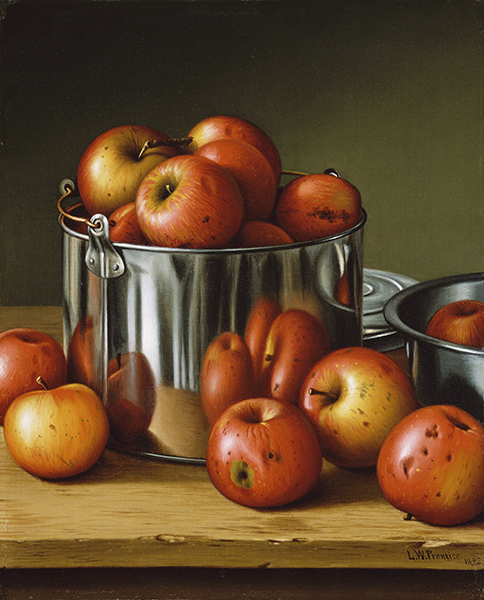October Is National Apple Month: Levi Wells Prentice
I can’t think of a better way to celebrate National Apple Month than with one of THE most incredible paintings I’ve ever seen on the subject. The first time I saw this painting by Levi Wells Prentice at the Museum of Fine Arts, Boston, I almost fainted from sheer excitement. Painting apples was a major part of this artist’s body of work.
 |
| Levi Wells Prentice (1851–1935, U.S.), Apples in a Tin Pail, 1892. Oil on canvas, 16 ¼" x 13 ¼" (1.3 x 33.7 cm). © 2023 Museum of Fine Arts, Boston. (MFAB-229) |
Born in the Adirondack Mountains region of New York state, Prentice was a self-taught painter. He initially painted landscapes inspired by Hudson River School paintings. In 1883, Prentice moved to Brooklyn. There, no longer surrounded by mountain landscapes, he turned to still life.
Prentice was most renowned in his day for his paintings of fruit, particularly apples, either growing on a branch in a landscape or in a still-life setting. Despite his self-training, Prentice became an expert of Trompe l'Oeil Realism, a technique very popular among burgeoning middle class art patrons. Prentice excelled at depicting reflection and dramatic contrasts of light and dark to achieve illusionism in his works, which few of the major stars of Trompe-l'Oeil Realism such as William Harnett (1848–1892) and John Peto (1854–1907) ever achieved.
Among the many styles American artists explored in painting during the late 1800s—including classicism, Impressionism and personal vision—trompe l'oeil (one of the many strains of the realism that dominated American painting) was the most unusual. Trompe l'oeil is French for “fool the eye.” The style emphasizes such fidelity to visual perception that the resulting image fools the viewer into accepting the image as the real thing.
The earliest exploration of trompe l'oeil in American painting came from Charles Willson Peale (1741–1827) in his painting The Staircase Group, a portrait of his sons Rubens and Titian. These works, like their Dutch Baroque counterparts, frequently had a narrative or moral associated with them when the highly detailed objects were scrutinized. The still-life subjects Prentice portrayed often touch on the vanitas theme typical of Dutch Baroque still life. In vanitas still life, the arrangement of abundance from nature is overwhelmed by its passing beauty, a symbol of the transience of human life.
Although very popular with the public, art critics at the time dismissed the trompe l’oeil genre as little more than technical proficiency. The artworks were popularly displayed in public places such as saloons and stores. The style reinforced the American appreciation for extreme realism in art. Such an appreciation was one reason that Impressionism was not readily accepted as a painting style when introduced in America in the 1880s, the same time Trompe l'Oeil Realism was wildly popular with the public.
Correlations to Davis programs: Explorations in Art 2E Grade 1: 1.5; Explorations in Art 2E Grade 4: 6.8; Explorations in Art 2E Grade 5: 2.1, 2.2, 2.3; Explorations in Art 2E Grade 6: 1.8; Experience Art: 2.2; A Personal Journey 2E: 2.6; A Global Pursuit 2E: 5.2; The Visual Experience 4E: 3.9


Comments